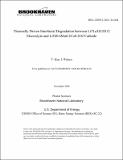| dc.contributor.author | Kim, Younggyu | |
| dc.contributor.author | Kim, Dongha | |
| dc.contributor.author | Bliem, Roland | |
| dc.contributor.author | Vardar, Gülin | |
| dc.contributor.author | Waluyo, Iradwikanari | |
| dc.contributor.author | Hunt, Adrian | |
| dc.contributor.author | Wright, Joshua T | |
| dc.contributor.author | Katsoudas, John P | |
| dc.contributor.author | Yildiz, Bilge | |
| dc.date.accessioned | 2021-11-22T19:01:06Z | |
| dc.date.available | 2021-11-22T19:01:06Z | |
| dc.date.issued | 2020 | |
| dc.identifier.uri | https://hdl.handle.net/1721.1/138194 | |
| dc.description.abstract | © 2020 American Chemical Society Solid-state batteries offer higher energy density and enhanced safety compared to the present lithium-ion batteries using liquid electrolytes. A challenge to implement them is the high resistances, especially at the solid electrolyte interface with the cathode. Sintering at elevated temperature is needed in order to get good contact between the ceramic solid electrolyte and oxide cathodes and thus to reduce contact resistances. Many solid electrolyte and cathode materials react to form secondary phases. It is necessary to find out which phases arise as a result of interface sintering and evaluate their effect on electrochemical properties. In this work, we assessed the interfacial reactions between LiNi0.6Mn0.2Co0.2O2 (NMC622) and Li7La3Zr2O12 (LLZO) as a function of temperature in air. We prepared model systems by depositing thin-film NMC622 cathode layers on LLZO pellets. The thin-film cathode approach enabled us to use interface-sensitive techniques such as X-ray absorption spectroscopy in the near-edge as well as the extended regimes and identify the onset of detrimental reactions. We found that the Ni and Co chemical environments change already at moderate temperatures, on-setting from 500 °C and becoming especially prominent at 700 °C. By analyzing spectroscopy results along with X-ray diffraction, we identified Li2CO3, La2Zr2O7, and La(Ni,Co)O3 as the secondary phases that formed at 700 °C. The interfacial resistance for Li transfer, measured by electrochemical impedance spectroscopy, increases significantly upon the onset and evolution of the detected interface chemistry. Our findings suggest that limiting the bonding temperature and avoiding CO2 in the sintering environment can help to remedy the interfacial degradation. | en_US |
| dc.language.iso | en | |
| dc.publisher | American Chemical Society (ACS) | en_US |
| dc.relation.isversionof | 10.1021/ACS.CHEMMATER.0C02261 | en_US |
| dc.rights | Creative Commons Attribution-Noncommercial-Share Alike | en_US |
| dc.rights.uri | http://creativecommons.org/licenses/by-nc-sa/4.0/ | en_US |
| dc.source | DOE repository | en_US |
| dc.title | Thermally Driven Interfacial Degradation between Li 7 La 3 Zr 2 O 12 Electrolyte and LiNi 0.6 Mn 0.2 Co 0.2 O 2 Cathode | en_US |
| dc.type | Article | en_US |
| dc.identifier.citation | Kim, Younggyu, Kim, Dongha, Bliem, Roland, Vardar, Gülin, Waluyo, Iradwikanari et al. 2020. "Thermally Driven Interfacial Degradation between Li 7 La 3 Zr 2 O 12 Electrolyte and LiNi 0.6 Mn 0.2 Co 0.2 O 2 Cathode." Chemistry of Materials, 32 (22). | |
| dc.contributor.department | Massachusetts Institute of Technology. Laboratory for Electrochemical Interfaces | |
| dc.contributor.department | Massachusetts Institute of Technology. Department of Nuclear Science and Engineering | |
| dc.contributor.department | Massachusetts Institute of Technology. Department of Materials Science and Engineering | |
| dc.relation.journal | Chemistry of Materials | en_US |
| dc.eprint.version | Author's final manuscript | en_US |
| dc.type.uri | http://purl.org/eprint/type/JournalArticle | en_US |
| eprint.status | http://purl.org/eprint/status/PeerReviewed | en_US |
| dc.date.updated | 2021-11-22T18:59:04Z | |
| dspace.orderedauthors | Kim, Y; Kim, D; Bliem, R; Vardar, G; Waluyo, I; Hunt, A; Wright, JT; Katsoudas, JP; Yildiz, B | en_US |
| dspace.date.submission | 2021-11-22T18:59:06Z | |
| mit.journal.volume | 32 | en_US |
| mit.journal.issue | 22 | en_US |
| mit.license | OPEN_ACCESS_POLICY | |
| mit.metadata.status | Authority Work and Publication Information Needed | en_US |
